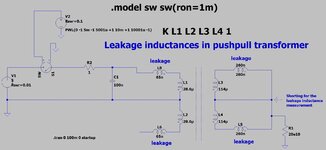cupoftea
Advanced Member level 6

Hi,
We have received from cust a synchronous pushpull 300w, 24vin, 32vout, 300w, 300khz, Planar txformer=ER32 at 1:2 (LP=28.6uH).
We’ve got to make it work. Its got no snubbers on the pri and sec FETs /Diodes. We will wire some in.
The planar txformer manufacturer tells us they measured 100nH of leakage L on one half of the primary, with all three secondary terminations shorted.
As such, do you agree, this must mean that leakage in each primary “half” is 200nH? Also, that leakage in each secondary “half” must be 400nH?
The attached LTspice is showing 2.6W total in the sec snubbers, and 11.6W total in the primary snubbers.
This is an awful lot. Do you believe that it is actually 200nH of leakage L in each primary half?
(my apologies, as i asked on this similar-ish subject recently, but not on the actual leakage figures, so there was no answers on this)

We have received from cust a synchronous pushpull 300w, 24vin, 32vout, 300w, 300khz, Planar txformer=ER32 at 1:2 (LP=28.6uH).
We’ve got to make it work. Its got no snubbers on the pri and sec FETs /Diodes. We will wire some in.
The planar txformer manufacturer tells us they measured 100nH of leakage L on one half of the primary, with all three secondary terminations shorted.
As such, do you agree, this must mean that leakage in each primary “half” is 200nH? Also, that leakage in each secondary “half” must be 400nH?
The attached LTspice is showing 2.6W total in the sec snubbers, and 11.6W total in the primary snubbers.
This is an awful lot. Do you believe that it is actually 200nH of leakage L in each primary half?
(my apologies, as i asked on this similar-ish subject recently, but not on the actual leakage figures, so there was no answers on this)


